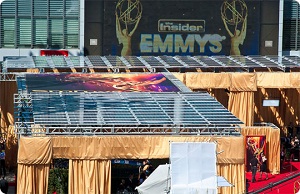Reviewing last week's solar energy news
 As we head into fall, we’re starting to reflect on what the first half of 2011 and all of 2010 have meant for the solar industry. There are shakeouts in the industry, partly because of manufacturing increases that, while good for the end customers, proves problematic for manufacturers. Still solar is making a bigger, more public splash than ever, like at this year’s Emmys.
As we head into fall, we’re starting to reflect on what the first half of 2011 and all of 2010 have meant for the solar industry. There are shakeouts in the industry, partly because of manufacturing increases that, while good for the end customers, proves problematic for manufacturers. Still solar is making a bigger, more public splash than ever, like at this year’s Emmys.
Increased production from low-cost chinese manufacturers has already forced three U.S.-based manufacturers to file for bankruptcy. As they struggled to lower prices, they ramped up production. And within a few short weeks, the first of the companies, SpectraWatt, will auction off its manufacturing equipment to the highest bidder. What will happen to manufacturing and intellectual property rights related to the other companies, Solyndra and Evergreen Solar remains to be seen.
To help prevent other solar manufacturing companies from falling prey to cheap Chinese imports, Sen. Ron Wyden (D) sent a letter to President Obama requesting he use existing tools to protect the U.S. solar industry from unfair competition from China’s photovoltaic industry, which the country has supported with tens of billions of dollars from its central bank.
Still the U.S. solar industry is a net exporter of goods, which includes manufacturing equipment being used in other countries to produce photovoltaics. A Solar Energy Industries Association and GTM Research report found that exports of solar goods exceeded imports of such goods by nearly $2 billion in 2010. The report shows that despite increased competition, the U.S. solar industry is still viable.
Educating the public about solar is an important way to increase its adoption. And there’s more of that going on than ever before. The red carpet at the Emmy Award show on Sept. 18 was covered by a 50-kilowatt SolarWorld photovoltaic array. The event is watched by 12 million to 13 million viewers annually and having the array on the red carpet provided an excellent opportunity to showcase solar.
FedEx Field in Landover, Md., home to the Washington Redskins, unveiled its 2-megawatt photovoltaic installation, using multiple photovoltaic technologies. At present it’s the largest installation at an NFL stadium, according to the company.
But the biggest impact to the future of solar may be through educating and familiarizing children with solar. To that end, SolarWorld introduced Energy for you and Me, a free educational booklet about solar power geared toward children and offered free to teachers and parents.
The first of the summer’s solar contests to close announced its winner last week. That’s SunRun’s “Battle of the Bills” contest. The winner of the contest was the Sato family in Oroville, Calif. The family’s electric bill was $2,400 in June 2011. They’ll receive 3-kilowatts of SunRun’s solar power service free for the next 20 years.
A key to developing lower-cost solar power is new technologies. Last week saw a number of advances on that front.
For instance, Natcore Technology showed off the feasibility of a two-junction photovoltaic cell consisting entirely of quantum-dots. The junctions and dots are able to absorb a wider range of sunlight than most other solar technologies.
Looking further down the technology pipeline, Harvard University, Universidad Nacional Autonoma de Mexico and Haverford College are using distributed computing to identify the most likely molecules to foment the next generation of organic photovoltaics.
Both projects could create solar technologies in the future eligible for funds through incubators like the SunShot Initiative. The DOE project recently announced $145 million in funding for advanced solar technologies to help bring down the cost of new solar technologies quickly.
Image courtesy of SolarWorld



